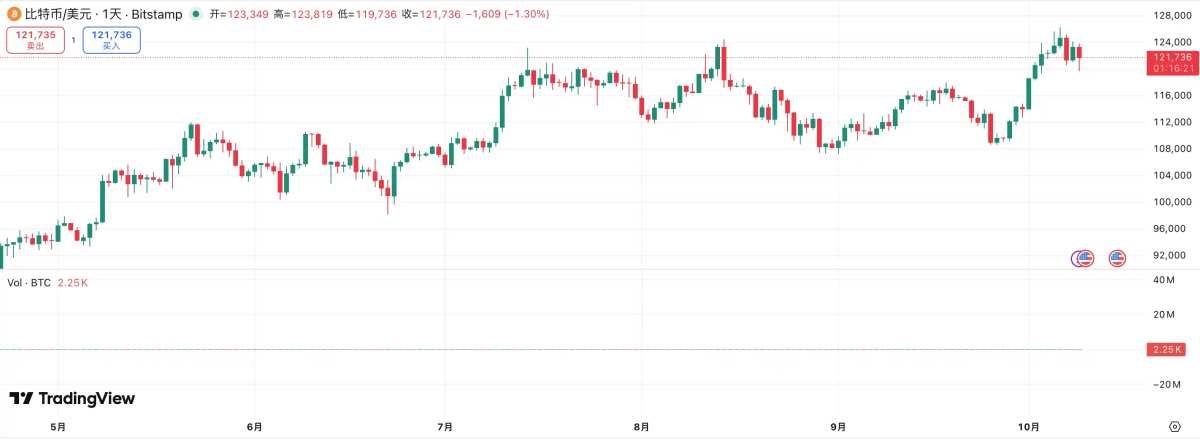How Will the October Market Perform After Bitcoin’s New High?
October 9, 2025
On October 6, Bitcoin surged past $125,000, once again setting a new historical high, marking the official entry of the market into a new round of frenzy. Accompanying BTC’s rise, mainstream altcoins like Aster and BNB experienced a significant surge, with liquidity on the BSC chain notably returning, and market sentiment has returned to the hottest phase of the year. The brief decline caused by the U.S. government shutdown has now been completely swallowed by the “FOMO-style market.”
From a macro perspective, the expectations of easing are providing solid support for risk assets. According to CME FedWatch data, as of now, the probabilities of interest rate cuts in October and December are as high as 94.1% and 84%, respectively. The market generally believes that the Federal Reserve has entered the “pre-communication phase” before a policy turning point, with dual easing in fiscal and liquidity becoming the main theme. Accompanied by a weak U.S. labor market, easing pressure on the debt ceiling, and continuous liquidity injections from the Treasury, there are signs of a decline in real dollar interest rates. Funds are accelerating their exit from the money market and flowing back into stocks and crypto assets. This round of increases is not only a preemptive reaction to the expectations of interest rate cuts and the resumption of liquidity but also a typical “fund-driven bull market.”

Next, Rhythm BlockBeats compiled traders’ perspectives on the upcoming market situation to provide some directional references for trading this week.
@CryptoHayes


Entering 2025, Hayes believes the world is returning to a “loose narrative.” The U.S. Treasury is releasing trillions of dollars in liquidity by issuing short-term government bonds, while the Federal Reserve is forced to restart interest rate cuts against a backdrop of high inflation; China, facing real estate recession and deflationary pressures, is once again loosening credit and stimulating domestic demand. Against the backdrop of monetary easing in both major economies, funds are bound to return to the risk asset market.
@Jackyi_ld
Liquid Capital founder Yi Lihua stated that a major bottom-fishing opportunity is coming, urging patience to filter out the noise. Sell when the crowd is clamoring and buy when no one is paying attention, seize good assets and then increase the quantity. The three major assets in the cryptocurrency circle that transcend cycles are: public chains (BTC, ETH, etc.), exchanges (BNB, Aster, etc.), and stablecoins (WLFI, Tether equity, etc.).
@Phyrex_Ni
The recent rise in the risk market is essentially a product of the market “anticipating” the Federal Reserve’s easing expectations. The U.S. government shutdown and Trump’s layoff plans have led investors to bet on an interest rate cut in October, causing U.S. stocks, cryptocurrencies, and gold to rise together. However, this “celebrating a funeral” market trend is more driven by emotions. In reality, the Federal Reserve is still in a high-interest-rate cycle, with rising inflation stickiness, slowing wage growth, and declining real purchasing power. Weak labor market data has instead exposed the structural risks in the economy.
On a macro level, the U.S. fiscal deficit continues to expand, with both U.S. Treasury yields and the dollar index rising, while gold prices are also strengthening. This reflects a global trend where funds are seeking safety in the dollar while simultaneously harboring doubts about the long-term repayment capacity of the U.S. In the short term, the data vacuum caused by the shutdown will continue to maintain an optimistic sentiment, and funds may continue to flow into risk assets, but this is merely a “false prosperity without data.” Once inflation data returns to high levels, the Federal Reserve will be forced to tighten policies, and the market may face a sharp turn.
@Corsica267
The current economic problems in the United States stem from the structural contradictions of weak demand and high debt. Long-term low interest rates and improvements in production efficiency have weakened investment returns and widened the gap between the rich and the poor, while aging and slowing consumption have further suppressed growth momentum. In the face of this “high debt + low growth” dilemma, Treasury Secretary Yellen is resolving the debt through a strategy of “financial repression”: fixing interest rate ceilings, tolerating inflation, and attracting passive buyers, so that the nominal growth rate of the economy exceeds the cost of financing, thereby “erasing” the debt burden.
This has led the market into a misalignment pattern of “nominal interest rate cuts ≠ substantial easing.” Even if the Federal Reserve cuts interest rates, if inflation expectations decline faster, real interest rates may actually rise, resulting in passive tightening. Currently, the division of labor between the Federal Reserve and the Treasury is: the former stabilizes livelihoods, while the latter stabilizes government bonds. Fiscal easing supports asset prices, while the Federal Reserve faces a difficult trade-off between employment and inflation.
In terms of assets, technology stocks and gold can resonate and rise together. Technology stocks rely on the decline in discount rates and long-term growth expectations, forming a “productive bubble”; gold benefits from the dual premium of falling real interest rates and rising institutional uncertainty. The simultaneous rise of both essentially reflects a pricing consensus in the era of financial repression—capital expects real returns to decline, while hedging and growth become the only certainties.
The future trend depends on:
If inflation is under control and fiscal suppression continues, risk assets and gold still have support;
If inflation rises again and real interest rates increase, the bubble will be forced to deflate.
In short, this is an era where financial repression is exchanged for growth, and institutional premiums support assets—prosperity coexists with risk, and the peak of valuation is also the low point of institutional trust.
@JPMorgan
J.P. Morgan analysts pointed out in a report on October 1 that Bitcoin is expected to continue rising. The reason lies in the resurgence of what is known as “currency devaluation trades”—that is, retail and institutional investors, concerned about geopolitical uncertainties, high global debt levels, and the weakening dominance of the dollar, tend to hedge risks by allocating gold and Bitcoin.
More broadly, recent developments in the cryptocurrency industry indicate that it is steadily integrating into the mainstream financial system, including the launch of several new cryptocurrency ETFs and the rise of “crypto treasury stocks,” demonstrating a continuous increase in the acceptance and participation of the capital markets in this field.
Search
RECENT PRESS RELEASES
Related Post




